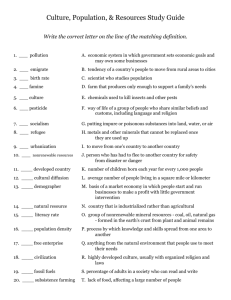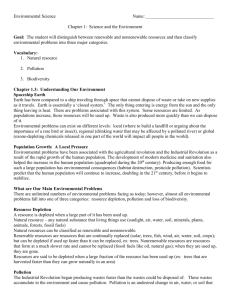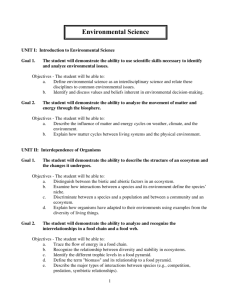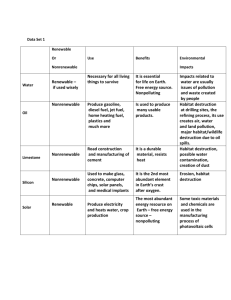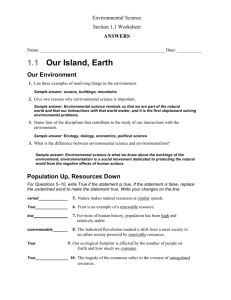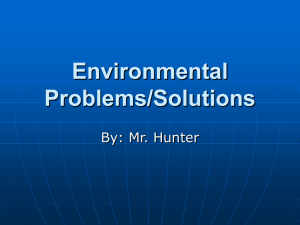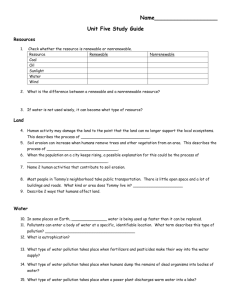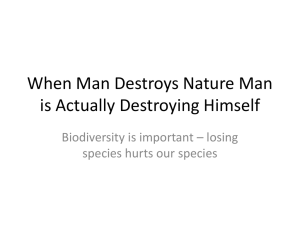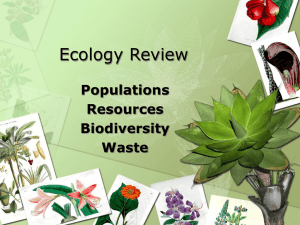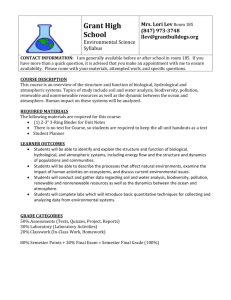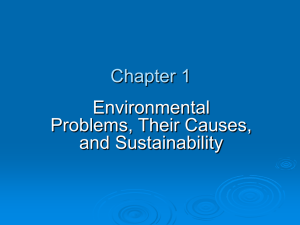ch1 ppt review
advertisement
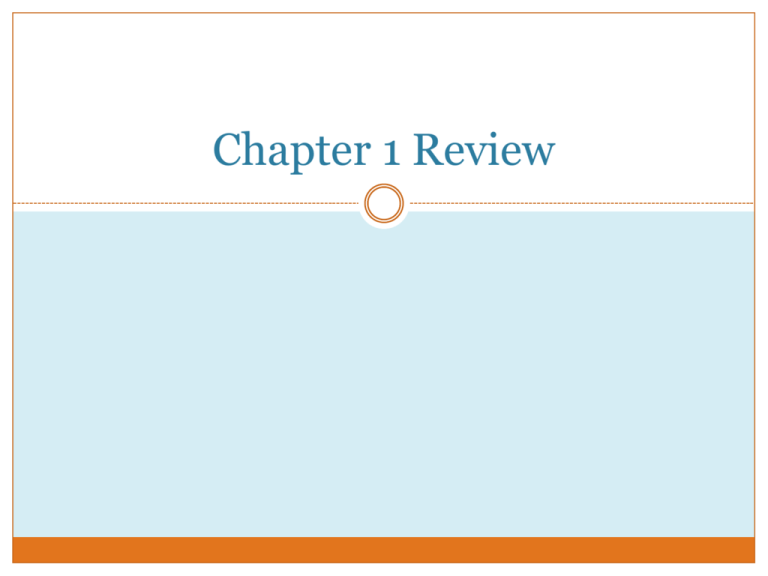
Chapter 1 Review 1 The study of relationships between living organisms and the environment Environmental Science Ecology Natural Capital Environmentalism Ecosystem 2 The interdisciplinary subject that combines information from the physical sciences and the social sciences to learn how the Earth works Environmental Science Ecology Natural Capital Environmentalism Ecosystem 3 Natural resources and natural services that keep us and other forms of life alive and support our economics Environmental Science Ecology Natural Capital Environmentalism Ecosystem 4 All of the following are examples of sustainability. Which of the following are sustainable practices: I implementing a mandatory recycling program II Installing a new fleet of diesel busses III installing solar panels to reduce reliance on nonrenewable resources I only I and II II only I and III III only 5 Which of the following best describes world population growth: World population has been increasing at a constant rate Population of the world is split evenly between developed and developing countries World population has been growing exponentially Population of the world has been rising dramatically since 1963 World population is expected to decrease in size from current values and be smaller by 2040 6 Which of the following factors is used by the UN to classify a nation as developed or developing? Gain in population Resource use Distribution of wealth in the population Degree of industrialization Annual birth rate 7 A resource that can be replaced in a human lifetime is known as a Conservative resource Nonrenewable resource Important resource Renewable resource Sustainable resource 8 ALL of the following are true of nonrenewable resources EXCEPT Exist in a fixed quantity and are exhaustible Nonrenewable resources formed on the geologic timescale of millions to billions of years Nonrenewable resources can be used on a sustainable yield basis to ensure they will always be available Include metallic minerals which can be recycled or reused Many of the energy sources we currently rely on are nonrenewable 9 Plants and trees can be cut down and replanted. These resources are therefore considered to be Renewable resources Nonrenewable resources Perpetual Exhaustible resources Sustainable 10 An ecological footprint is defined as The impact an individual may have on a given area of land The amount of biologically productive land and water needed to sustain an individual within a population The carrying capacity of the earth for a given population The amount of land and water that has been converted to nonproductive use within a given geographical region None of these 11 A measure of a nation’s economic development based on a measure of per capital GDP PPP which includes all of the following EXCEPT Annual market value of all goods produced within the country Annual market value of services operating within the country Disparity of wealth between individuals within the country The total population at midyear Comparison of individual purchasing power based on currency rates 12 The “Tragedy of the Commons” refers to the overuse of: Free-access resources Government subsidies Privately owned resources Venture capital Corporate revenue 13 Environmental degradation is: A type of pollution which cannot be broken down in the environment Harmful materials which can be broken down in natural systems When we exceed or compromise a renewable resource’s natural replacement rate, the available supply shrinks A type of environmental ethic in which human needs and intelligence allows us to use resources as we wish A system of measurement used by environmental scientists to rate the health of a specific system 14 Point pollution sources Can usually be ID within a given area Can never be located Are dispersed and difficult to ID Are much more expensive to control than Nonpoint sources Cannot be controlled 15 All of the following are true with respect to pollutants EXCEPT They disrupt life-support systems for living organisms They can damage property They create nuisances within an environment They contribute to the balance within an ecosystem They can be a hazard to human health 16 A pollution prevention strategy would include: Government spending more money on clean-up initiatives Using incineration of waste thereby reducing the volume of solid waste and moving the pollution to a smaller air pollution problem Land being set aside for the burial of pollutants to allow the environment to naturally deal with existing pollutants Replacing old polluting systems with new technology which does not result in problematic waste Creating efficient waste collection and management systems in communities 17 Which of the following are considered to be causes of key environmental problems: I population growth II unsustainable resource use III poverty within a population II only II and III only I and II only I, II, and III I and III only 18 The environmental impact of a population on a given area depends on I population size II combined environmental effects of technologies III affluence-level or consumption patterns within the population I only I and III II only I, II, and III I and II 19 Environmental ethics can best be defined as: Using the environment wisely Maintaining environmental sustainability Examining the moral basis of environmental responsibility and its extent None of these All of these 20 If you wanted to determine if a resource was being used in a sustainable way, which of the following data would you analyze? The difference between the demand for the resource and the availability of the resource The total amount of the resource available The rate at which the resource was being recycled The difference between the rate of resource consumption and the rate at which the resource is replenished The change in population size since that resource was introduced 21 Nutrient cycling is: The circulation of chemicals necessary for life through the living and nonliving systems of the environment One of the natural services of our ecosystems A scientific principal of sustainability Illustrated by the process of decaying matter returning nutrients to the soil to be taken up again by plants All of the above 22 According to the World Health Organization (WHO), poverty often results in premature death due to all fo the following reasons EXCEPT Malnutrition Limited access to adequate sanitation Sever respiratory disease from indoor air pollution Available clean drinking water Lack of access to health care 23 Affluence results in a safer, often more environmentally managed society in all the way EXCEPT Clean drinking water Abundant and safe food supply Increased resource use Reduction in life-threatening disease Education which spurs new technology, research, and environmental awareness 24 Consider the following data on population size and land area. Which of the countries has the highest population density? Country population (in millions) 1st # column Land area (in millions of hectares) 2nd # column Country A 12 4 Country B 10 0.5 Country C 33 5.5 Country D 10 30 Country E 10 10

